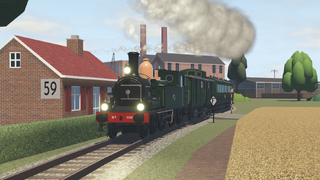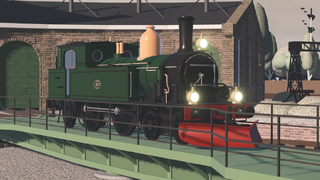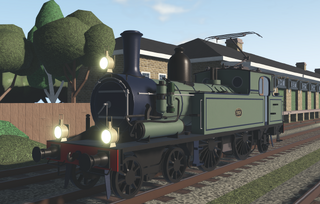 | |
| NS 5500 | |
|---|---|
| by Supersnel11 & Synchorus | |
| Price | ƒ41.000 |
| Level | 12 |
| Statistics | |
| Type | Passenger |
| Top Speed | 90 km/h |
| Weight | 63 tons |
| Capacity | 360 tons |
| Passenger Capacity | 1 first class 2 second class |
| Length | 12,3 meters |
The NS 5500 was a class of 55 Dutch 2'B'1t (4-4-2T) mainline engines. They ran services backwards so often that they were called "kop-en-kontjes" (head and buttocks).
Variants
The NS 5500 is only available in Nederlandsche Spoorwegen green. It had a snowplough livery during the winter update of 2021.
Historic details
The HSM years
The Hollandsche IJzeren Spoorweg-Maatschappij (HSM) was very enthusiastic about their series 350-408 and 601-647 (later the NS 1600 & NS 3200 respectively) from Sharp Stewart & Co. and decided to purchase tank engines from them. The ex-NRS 1'B'1 (2-4-2) tank engines did suffice, but were too light for the increasingly heavy trains, so the HSM 701-724 were ordered as a heavier continuation. These would be the second series of tank engines the HSM ever bought, with the first being two 1'B tank engines from 1874.
Sharp Stewart delivered the first eight in 1898, followed by 13 more in 1899 and the last five in 1900. The first 24 locomotives were such a success that the HSM altered one of their orders at Werkspoor to also include another 31 locomotives of this type. Werkspoor delivered the HSM 726-755 between 1903 and 1905. Following the example of their goods locomotives, the HSM also ordered a version of this series that was fitted with a superheater; these would later become the NS 5700.
The first depots the Sharp Stewart locomotives were stationed at were Haarlem, Leiden and Rotterdam. After the Werkspoor locomotives were also put into service, half of the series went to depots in the province Noord-Holland (Amsterdam, Alkmaar, Den Helder & Hoorn) and some were stationed at depots in Zuid-Holland (Hoek van Holland, Den Haag & Rotterdam). Outside of Holland they were only stationed at Nijmegen, Arnhem, Amersfoort and Winterswijk. They mostly pulled local trains from these depots, though the locomotives stationed at Haarlem got the occasional sand train from the sand extraction sites there.
The locomotives stationed at Hoorn were all moved to Den Haag in 1908 to assist on the lines of the early Dutch electric company ZHESM, which did not have enough electric locomotives available. The locomotives at Hoek van Holland had a monopoly on the trains from and to Rotterdam, but some moved to Enkhuizen, Dordrecht and Leeuwarden after restrictions on the train schedules created a surplus of available engines.

The NS years
After the fusion between the HSM and Staatsspoorwegen (SS), the locomotives were renumbered to NS 5501-5555. They were stationed mostly in the Westside of the Netherlands. Throughout the 1920s, members of the class were stationed at various ex-SS depots. But in the same decade, the West of the Netherlands was also electrified. At that point the NS 5500 became good replacements of the old B (0-4-0) locomotives that still roamed the branch lines in other parts of the country, so they were slowly spread across depots. In the 1930s they were stationed at the depots Groningen and Leeuwarden and drove on all the branch lines in the North of the Netherlands. The coal bunkers were enlarged just for the service on these lines.
In May of 1940, NS 5540 was destroyed, but the others remained in service. The occupying forces took 34 to Germany in the winter of 1944. Only 11 of the 5500s that returned from Germany could be repaired. Of the 20 that remained behind, only ten were operational and four were destroyed beyond repair.
This left 39 5500s operational and in service after the war, however, they did not have a lot of time left. The withdrawals began in 1948. Most of them were stationed in Groningen, Leeuwarden and Hengelo and took care of the passenger trains around those cities. Only 21 were still in service by the end of 1951. These would all be withdrawn between then and 1954. The "Blue Angels", as the Dutch called the DE-1s, had taken over their branch line work.
Technical details
The NS 5500 were originally equipped with Westinghouse-brakes (automatic and independent), connections for steam heating on the front and back, a Stroudley-speedometer, two Gresham & Craven-injectors and Gresham & Craven steam-powered sanders.
The 5500s were build in the same style as the HSM 359-409 (NS 1600) and HSM 601-47: the firebox and cylinders were identical, the bogie was identical to those of the 359-409. The trailing wheels had Cartazzi-axle bearings and could move 28 mm sideways.
The brakes only worked on the driving wheels. The Westinghouse-brakes were equipped with simple air brakes but the last six were fitted with a braking system made by the New York Air Brake Company.
The locomotives were fitted with a Knorr pre-heater with a heating surface of 9,2 m² and a pump with a capacity of 120 litres per minute starting in 1916, which replaced the injector on the left side. The safety valve on the steam dome was removed in the 1920s as it was no longer required by law. Some 5500s received a steam-powered bell in 1923, which was replaced with an air-powered one four years later, for branch line services. The bells were removed when the class was taken off branch line duty, but was replaced again in the war for services on German lines.
In 1932, the coal bunkers behind the cab were heightened which doubled the coal storage capacity to 4 tons. The water tanks remained unchanged. The small water capacity made the locomotives unsuitable for longer services, so a handful of locomotives were given a "tender" during the war; tankers filled with water which were connected to the locomotive by hose.
The modification was deemed a success. 20 locomotives were rebuilt to make use of the tankers permanently in 1944. The chosen tankers had a capacity of 11,2 m³, making the locomotive's total water capacity 17,1 m³.
Trivia
- The NS 5500 is a low-mid level passenger tank engine, perfect for stopping trains, and light express trains too.
- During the 2023 April Fools event Screamlined, an electric version of the NS 5500 was available.
- The rear axle does not pivot, and has fixed lateral movement.
- The chuffing loop between 40km/h to 65km/h features cameras snapping pictures in the loop.
- The NS 5500 is one of two steam locomotives without extra whistle sounds, only having one sound file.
- The other being SS 326 (Grote Groene), which also has a single whistle audio file.
- The NS 3600, a 4 cylinder locomotive, has a lower capacity ingame than the NS 5500, which is a small 2 cylinder tank engine.
- The NS 5500 was originally revealed at Streamlined's stand at Transport Tech 2021.
- In version 0.4.44, the NS 5500 received a temporary snowplough livery for the winter season of 2021.
- Strangely, the snowplough has not returned for any subsequent winter updates.
- The NS 5500 was added in version 0.4.24.
- It was originally planned to be available on launch.
Gallery
-
NS 5529 drives through the cutting near Wezinge.
-
NS 5510 on the Kroosdrichem branch.
-
The NS 5500 with it's snowplow.
-
The 2023 April Fools Electric NS 5500.




